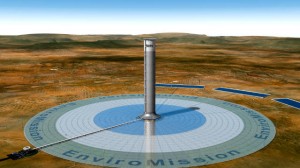By Tiffany Kaiser www.dailytech.com
The solar tower could produce 200 megawatts of power per day, which is enough to power 100,000 homes

Sometimes it’s not so bad being full of hot air.
Roger Davey, an Australian entrepreneur and CEO of renewable energy company EnviroMission, is looking to use hot air as a way of creating clean energy for cities.
To do this, Davey plans to build a 2,600-foot tall solar updraft tower with 32 turbines capable of creating 200 megawatts of power per day. This is enough to power 100,000 homes.
The tower, which would be the second tallest building in the world after Dubai’s Burj Khalifa skyscraper, will be placed in the Arizona desert. It works by creating solar-thermal power from the sun and the wind, where the sun heats up air underneath a translucent covering around the tower. The air is then heated to 194 degrees Fahrenheit, and makes its way into the tower to spin the turbines and rises — the taller the tower, the stronger the flow of air.
This concept trumps conventional solar photovoltaic panels because the tower can continuously generate energy even after the sun sets because the ground releases heat through the night.
This technology also doesn’t require the use of water to generate electricity.
The tower itself would be built from cement, have no support wires and would last 80 years, which is much longer than most fields of solar panels. According to EnviroMission, the amount of pollution created to build the tower will be offset after two and a half years of operation. The estimated cost for the Arizona desert project is $750 million.
The tower would take about two years to build, and could create 1,500 construction jobs. While it is only a concept for now, its intentions have been proved by a smaller-scale version that EnviroMission created in Spain. After making improvements on and working with the 50 kilowatt-per-day tower in Spain, EnviroMission is ready to make the next step in building the large, clean energy tower in Arizona.
EnviroMission is now working out the final capital costs.
“One of the most important things I think that differentiates this from anything else is its ability to produce power as and when required,” said Davey.














